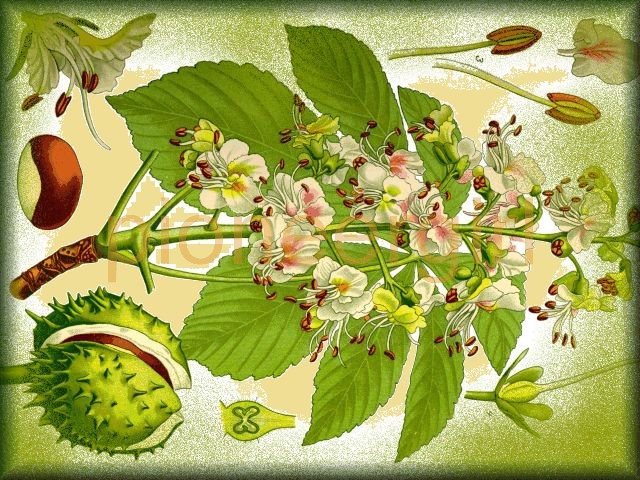chestnut / horse chestnut

chestnut. The fruit, seed, or nut of a tree belonging to the genus Castanea (C. vesca), enclosed in a prickly pericarp or burr. The tree itself, or its timbers. a. Being of the color of a chestnut; of a reddish brown color. — Webster, 1882
horse chestnut. A large nut, the fruit of a species of Æsculus (Æ. hippocastanum), formerly ground, and fed to horses, whence the name. (b.) The tree itself, which was brought from Constantinople in the beginning of the sixteenth century, and is now common in the temperate zones of both hemispheres. The American horse-chestnut is the buckeye. — Webster, 1882
 Today I saved a horse chestnut, and we came to hazelnuts for the first time. – On the Way Home, August 15, 1894
Today I saved a horse chestnut, and we came to hazelnuts for the first time. – On the Way Home, August 15, 1894
 In Farmer Boy, Almanzo Wilder and his father admire the Morgan horses at the County Fair (see Chapter 21, “County Fair”). These horses are described as being colored bay (a red horse with black mane, tail, lower legs, and ear tips), brown (black or brown coat with lighter muzzle, flank, belly, around the eye, girth, or inner thigh), or chestnut (reddish to brown coat with a mane and tail the same color or lighter in color than the coat).
In Farmer Boy, Almanzo Wilder and his father admire the Morgan horses at the County Fair (see Chapter 21, “County Fair”). These horses are described as being colored bay (a red horse with black mane, tail, lower legs, and ear tips), brown (black or brown coat with lighter muzzle, flank, belly, around the eye, girth, or inner thigh), or chestnut (reddish to brown coat with a mane and tail the same color or lighter in color than the coat).
Chestnut is one of the most common horse coat colors, and it can be found in almost every breed of horse. The colt at right is a chestnut; the photograph was taken at the Ingalls Homestead in De Smet, South Dakota.
 Horse chestnut. While traveling through Kansas, Laura Ingalls Wilder wrote that she found a horse chestnut. Different from the true chestnut of “The Christmas Song” (Chestnuts roasting on an open fire… Castanea dentata), the horse chestnut (Aesculus hippocastanum) – and the buckeye (Aesculus glabra) – are similar in looks, but are not edible. They are, however, considered to be good luck or cure rheumatism when carried, which is perhaps why Laura picked one up!
Horse chestnut. While traveling through Kansas, Laura Ingalls Wilder wrote that she found a horse chestnut. Different from the true chestnut of “The Christmas Song” (Chestnuts roasting on an open fire… Castanea dentata), the horse chestnut (Aesculus hippocastanum) – and the buckeye (Aesculus glabra) – are similar in looks, but are not edible. They are, however, considered to be good luck or cure rheumatism when carried, which is perhaps why Laura picked one up! 
The horse chestnut is a native of Europe, but was brought to American and planted widely as an ornamental shade tree. Growing in shade up to about 40 feet tall, the tree has leaves made up of seven leaflets with coarse “teeth.” The tree contains showy spotted flowers of white tinged with red or yellow, which appear in May. Nuts are contained in spiny husks. The name buckeye refers to the appearance of the brown nut through the paler husk partly separated when ripe, suggesting the eye of the common deer.
Horse chestnuts are slightly poisonous and should not be eaten.

chestnut (FB 21)
horse chestnut (OTWH August 15)

